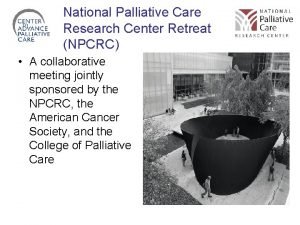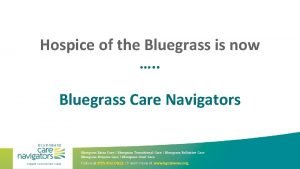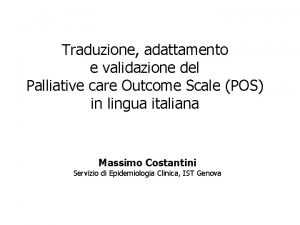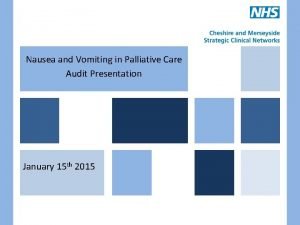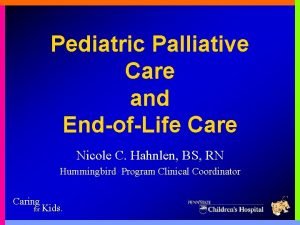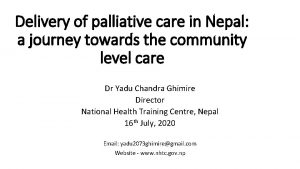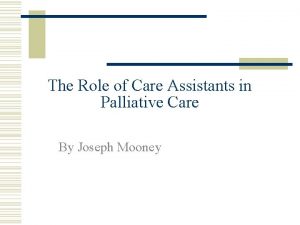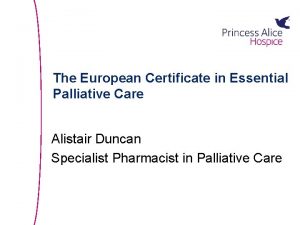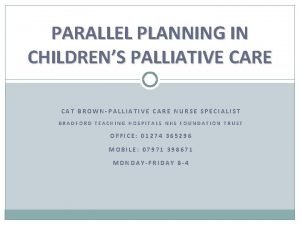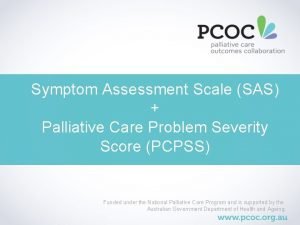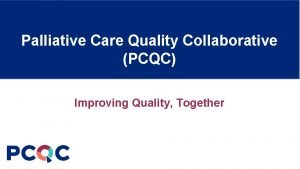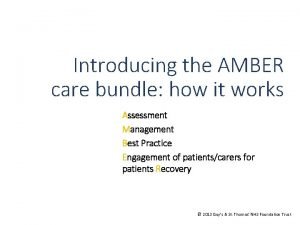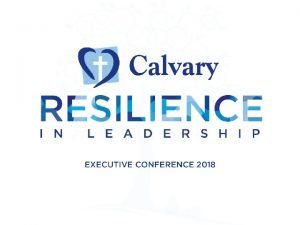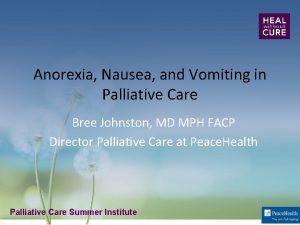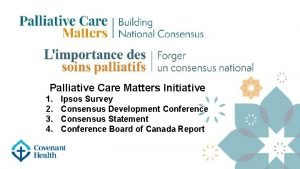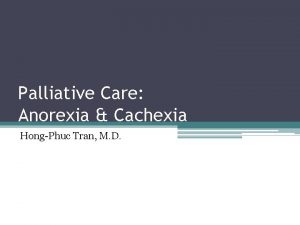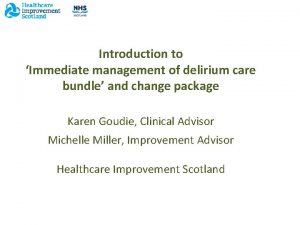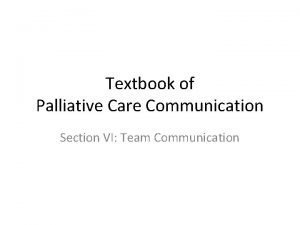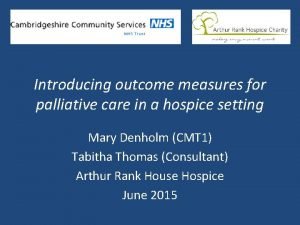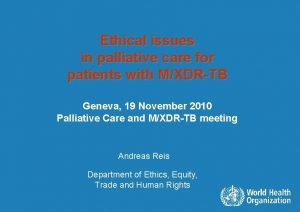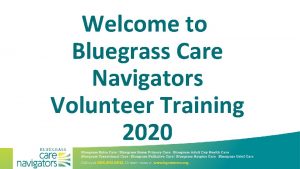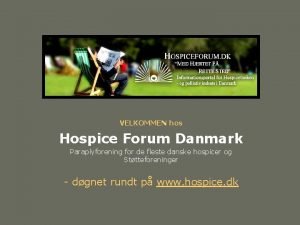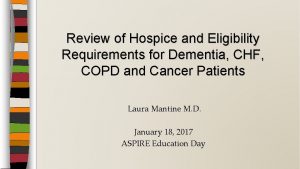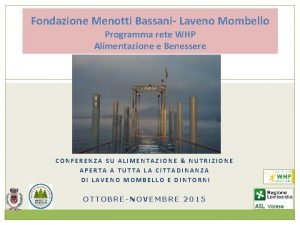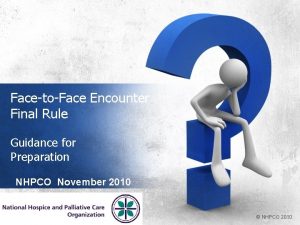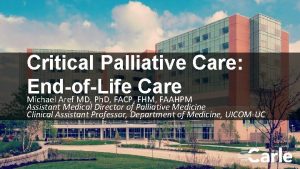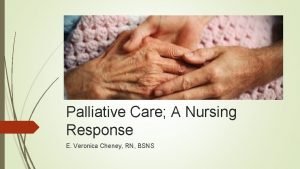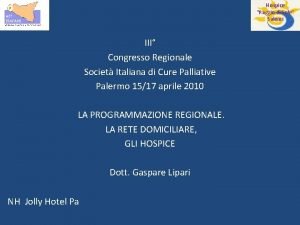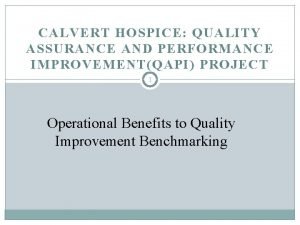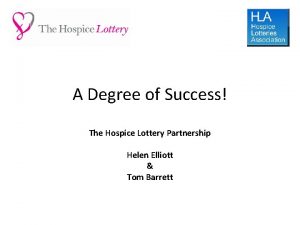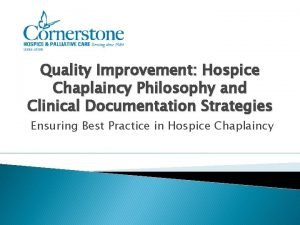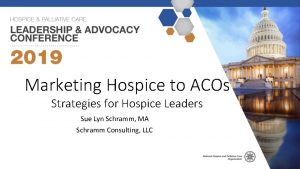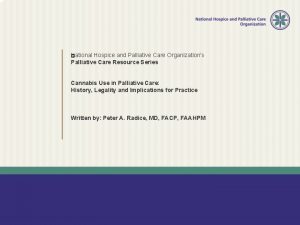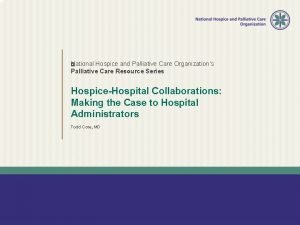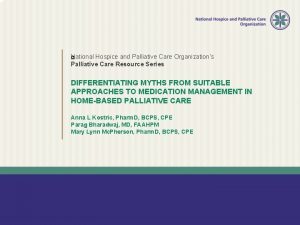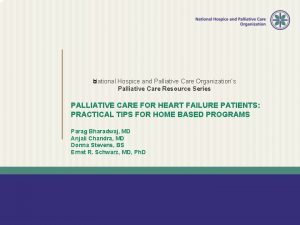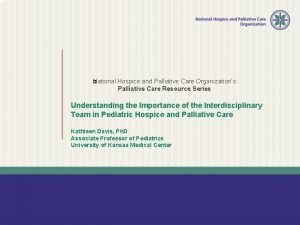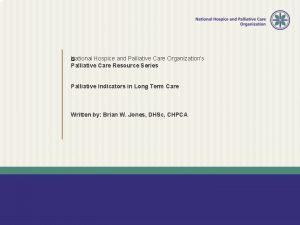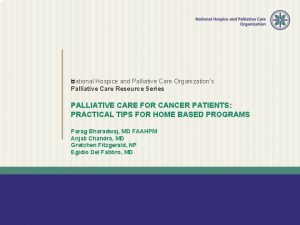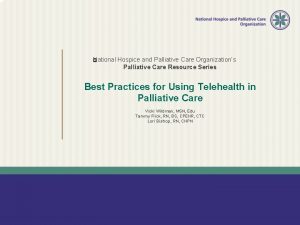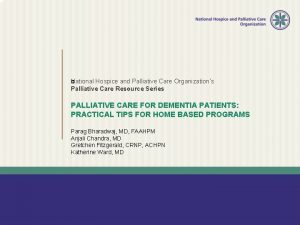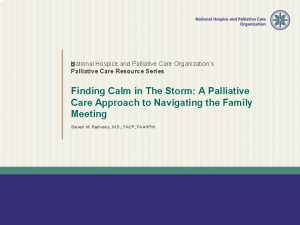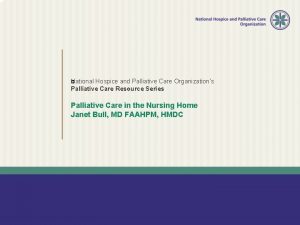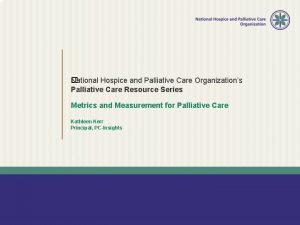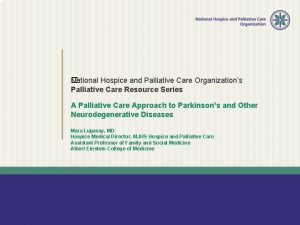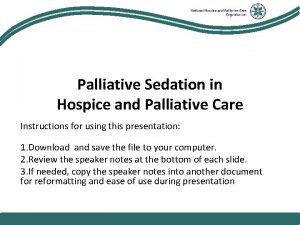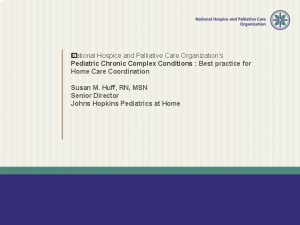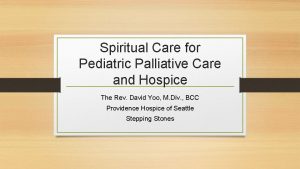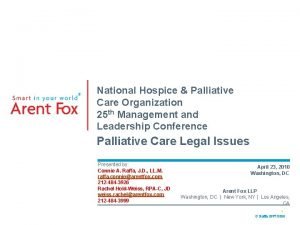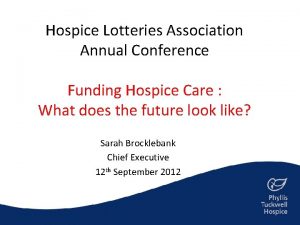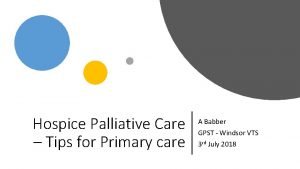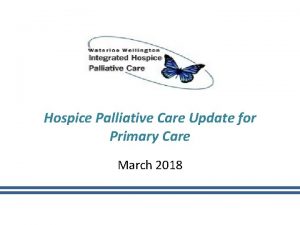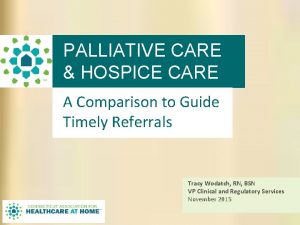National Hospice and Palliative Care Organizations Palliative Care











































- Slides: 43

National Hospice and Palliative Care Organization’s � Palliative Care Resource Series Family Caregivers in Palliative Care and Hospice: Minimizing Burden and Maximizing Support Written by: Myra Glajchen, DSW Director of Medical Education MJHS Institute for Innovation in Palliative Care

Caregivers in Palliative Care � • P �rovide substantial care to patients with serious illness and are themselves in need of care • Involved in direct care, decision-making, goal setting, advance care planning. • Professionals play a vital role integrating caregivers into plan of care and supporting them. • Information will present conceptual framework for working with caregivers across trajectory of advanced illness

Conceptual Framework • • Stress Process Model Attachment Theory Mutuality Bereavement Care Transitions Domains of Palliative Care The Family Meeting Caregiver Research

Conceptual Framework: Stress Process Model • Contextual factors – Fixed characteristics = age, gender, relationship – Dynamic characteristics = living arrangements, relationship quality, family functioning, developmental stage • Caregiver stressors ebb and flow over time – Role overload can lead to feeling captive – Caregiver burden occurs when demands exceed coping Pearlin, 2010; Fletcher, 2012

Conceptual Framework: Attachment Theory • Strong attachment is related to commitment to provide care • Strong attachment is associated with lower sense of subjective burden • Sense of obligation is related to greater sense of burden Bowlby, 1981

Conceptual Framework: Mutuality • Positive quality of the relationship between caregiver and patient • Better relationship quality is associated with lower level of burden, depression and resentment • Marital satisfaction predicts better role adjustment among spouses Kim, 2008; Schumacher, 2008

Conceptual Framework: Grief and Bereavement • Loss: being deprived of someone or something important • Grief: normal reaction to loss • Bereavement: grief after death of someone close • Mourning: psychological process of integrating grief; culturally determined • Anticipatory grief: expectation of the death

Assessment • Physical well-being • Social well-being • Psychological well-being • Spiritual well-being • Cultural well-being

Assessment: Physical Well-Being • Can primary caregiver provide assistance with ADL’s and IADL’s? • Is caregiver willing and able to monitor symptoms? • Can caregiver assist with management of prescription medications? Stenberg et al, 2010; Bakas, 2001

Assessment: Physical Well-Being • Assess living arrangements – Living with patient is associated with higher burden • • Sleep disruption and deprivation Joint, muscle problems Fatigue Lower self-care • Bathing and toileting associated with lower well-being • Immune system deficiencies • Increased mortality Schulz R, Beach SR, 1999

Assessment: Physical Well-Being • Survey of 1, 677 family caregivers in the US – – – 46% performed medical and nursing tasks 78% managed medications, IV’s, and injections 35% were doing wound care 35% functioned as care coordinators 69% had no home visits by HCP’s Over 50% said they felt they had no choice, no one else to help, and insurance would not cover services – Reported both negative and positive effects – Most caregivers felt they were helping to avoid institutionalization AARP, 2012

Assessment: Social Well-Being • Living with patient is associated with isolation • Some caregivers experience erosion of social support • Most have financial concerns • Employment is protective for caregivers, form of social support • Social support network

Assessment: Psychological Well-Being • Assess caregiver for depression • Assess caregiver for anxiety • Use past coping to assess strengths and resources • Assess family’s developmental stage: – How will the illness and treatment demands affect the family unit? – What losses are typically associated with this life stage? Raveis, 2005; Stroebe et al, 2006

Assessment: Spiritual Well-Being • Conduct a spiritual assessment • Assess existential perspective on hope and suffering • Strengths: – Faith – Meaning • Risk factors: – Crisis of faith – Hopelessness – Anger –why me?

Assessment: Cultural Well-Being • Cultural norms must be respected • Cultural differences between professionals and patients can lead to underestimation of caregiver distress • Cultural imperative may pose barrier to accessing formal service • Taboos against verbalizing death obscure care planning • Professional interpreters should be used instead of family Aliyu, Adediran, & Obisesan, 2003; Weiner, Arnold et al, 2006; Glajchen, Homel et al 2003.

Caregiver Assessment • Caregiving can be rewarding • This area is less well developed in research • Potential rewards – – – Discovery of personal strength through adversity Improved sense of self-worth Deepening of the relationship with the patient Sense of personal growth Sense of fulfilling an obligation Balducci, 2008

Caregiver Assessment • Family caregivers (n=125) of patients receiving specialized palliative care were recruited from 4 settings • Caregivers answered a questionnaire that included the Rewards of Caregiving Scale (RCS) • Results demonstrated that more prepared caregivers with higher levels of hope felt more rewarded. • Caregivers with higher levels of anxiety and spouses felt less rewarded by caregiving. • Although the caregiving role is complex, preparedness, anxiety and hope can and should be targeted. Henriksson A, Carlander I, Arestedt K, 2015

Best Practices for Integrating Caregivers: Care Transitions and Domains • Care Transitions – – – – – Diagnosis: integrate medical decisions Treatment: make decisions, juggle demands, provide support Recurrence: treatment, manage symptoms, preserve hope Home care: manage patient at home, adjust environment Placement: adjust to an institution, change in role status Palliative care: functional limits, new goals of care, new team Hospice: new goals of care, supportive care focus Survivorship/Cure: resume normal life, with uncertainty Death: witness patient suffering, achieve closure Bereavement: grieve the death of a loved one

Domains of Palliative Care • Clinical Practice Guidelines for Quality Palliative Care • Published by the National Consensus Project for Quality Palliative Care, Third Edition, 2013 • Eight domains of palliative care • Can inform our work with family caregivers

Domain One: Structure and Processes of Care • Ask patient to identify primary caregiver(s) • Meet separately with primary caregiver to assess needs • Involve caregiver in decision-making from the start • Validate the role of the caregiver • Educate caregivers about diagnosis, prognosis • Review range of treatment options with benefits and burdens • Ensure caregivers understand different settings of care

Domain Two: Physical Aspects of Care • Assess fatigue, sleep disruption, functional limitations • Assess caregivers willingness, ability to help with ADL’s, IADL’s • Environmental assessment of home • Home care services can alleviate caregiver burden • Skills training can increase preparedness • Encourage self-care

Domain Three: Psychological & Psychiatric Aspects • Mild anxiety and depression respond well to counseling • Counseling can provide support • Intervene to help caregivers manage psychological reactions • Reinforce resilience and past coping • Consider referral for more persistent, longstanding, or complex psychiatric comorbidity • Start the work of anticipatory bereavement

Domain Three: Psychological and Psychiatric Aspects • As a direct consequence of assuming the caregiver role, caregivers in the palliative, hospice, and bereavement phases are at increased risk for psychiatric morbidity • Psychological burden of the caregiver can exceed that of the patient • Distressed caregivers can influence patient well-being • Interventions are needed to directly support caregivers Williams AL, Mc. Carkle R, 2011

Domain Three: Psychological & Psychiatric Aspects • Caregivers differ in their responses to the loss of a loved one • Over 50% of bereaved caregivers report clinically significant depressive symptoms 1 year after the death of their loved one • Being bereaved predicts poorer mental health and greater psychological distress 8 years after the death • Models of attachment maintained by relationships in adulthood play a role in determining the nature and severity of grief reactions following loss of a spouse

Domain Three: Psychological & Psychiatric Aspects • Predictors and Risk Factors – Better quality of patient death reduces risk of bereavement regret – Incidence of major depressive disorder is more likely for caregivers with mental health difficulties before the loss of the patient – Completion of a DNR order is predictive of improved mental health from before the death of the patient to after the death

Domain Four: Social Aspects of Care • Isolated caregivers need more help from the formal system • Family meetings provide a safe setting in which to share decision-making and achieve consensus • Caregivers benefit from entitlements, financial assistance, community resources • Skills training improves competence and confidence

Domain Five: Spiritual, Religious, Existential • Conduct spiritual assessment • Address suffering, regret, legacy, closure • Make spiritual care available • Document discussion of spiritual and religious concerns • Document issues that the patient and caregiver do not wish to discuss

Domain Five: Spiritual, Religious, Existential • A recent hospice study identified the importance of addressing relational conflicts if these are important • Caregiver priorities: regret, shame, desire to repair the relationship, forgiveness • Opportunities for life closure, growth, emotional healing, and reconciliation exist even in the setting of end of life Exline JJ, Prince-Paul M, Root BL, et al, 2012

Domain Six: Cultural Aspects of Care • Respect language • Tailor information to patients’ and caregivers’ level • Understand cultural beliefs and preferences for truth-telling, decision-making, burial • Communicate cultural values to learn • Use professional interpreter

Domain Seven: Care of the Patient at the End of Life • Communicate signs and symptoms of death • Be vigilant in language • Help demystify emotionally charged terminology including: – – – Comfort care Patient is DNR Persistent vegetative state There is nothing more we can do Do you want us to stop everything? • Intensify caregiver support

Domain Seven: Care of the Patient at the End of Life • Poor psychological health outcomes exist beyond the first year of bereavement • Over 52% of caregivers in one study had one or more suspected psychiatric disorders, mostly anxiety • Comprehensive evaluation of psychiatric morbidity is often missing in clinical practice due to time resources Rumpold T, Schur S, Amering M, et al 2015; Masterson MP, Hurley KE, Zaider T, et al 2015

Domain Eight: Ethical and Legal Aspects • Help patient identify surrogate • Make surrogate agrees to assume the role • Ensure surrogate understands patients wishes • Document goals of care and treatment preferences • Identify Health Care Proxy Form, have it witnessed • Help patient complete advance directives – Living will vs oral • Convert treatment goals into medical orders

The Family Meeting • No single definition exists in the literature • Valuable clinical tool for: – – – Communicating medical information Delineating goals of care Facilitating decision-making Paying attention to patient preferences Safe setting in which to process emotions • Patient should participate if able • Important venue to acknowledge central role of caregiver • Can be called by patient, family or staff

Family Meeting Triggers: Palliative Care • Family conflict or crisis • Longer length of stay • Absence of designated health care agent • Major care decisions • Discharge planning • To share unwelcome prognostic information Billings, 2011

Family Meeting Triggers: Hospice • Change in medical status • Transition points in care • Advance care planning • Patient/surrogate decision making • Conflict resolution • Ethical dilemmas Back A, Arnold R, Tulsky J, 2009, Hudson P, Quinn K, O’Hanlon B, Aranda S et al, 2008

Family Meetings: Do They Benefit Caregivers? • Place to validate central role of caregivers • Creates a safe environment for goals of care discussions • Best to follow caregivers’ agenda, open-ended questions • Important to checking pts’ and caregivers’ understanding • Place to help caregivers to process intense emotions, providing support • Lends itself to interdisciplinary care • Can be a forum to share decision-making, reach consensus

Family Meetings: Best Practices • Optimal number: less is better, number of staff should not overwhelm family • Optimal time: 1 hour prep, 1 hour meeting, 30 -60 minutes follow-up • Optimal choice of participants: – Patient – Caregivers invited by the patient – Involved health care professionals

Family Meetings: Best Practices • Literature on the family meeting is still relatively new • Existing studies suggest benefits outweigh the risks – Canadian study confirms the value of planned multidisciplinary family meetings in specialist inpatient palliative care units – Family caregivers reported a statistically significant increase in having their care needs met, in a before-after Australian study using a trained palliative care nurse; they also reported that the meetings were useful Hannon, O’Reilly, et al 2012, Hudson, Thomas, 2009.

Family Meetings: Best Practices • Is the family meeting associated with higher satisfaction? • How do we document family meetings? • How do we measure outcomes and define success? • Does the family meeting cost or save money? • Are outcomes affected by meeting length, space, number of participants • Does individualized planning for family meetings reduce ad hoc and informal meetings, saving teams time?

Caregiver Research • What benefits the patient benefits the caregiver • Earlier referral to palliative care and hospice reduces patient’s symptoms and also benefit caregivers • Earlier hospice referral and longer enrollment are associated with less caregiver depression • Lower rates of ventilation, resuscitation, less ICU time are associated with higher satisfaction and less PTSD.

Caregiver Research • Joan Teno’s group evaluated US dying experience • Survey of family members/other informants: 1578 decedents • Asked about patient’s experience at last place of care which patient spent more than 48 hours • Did healthcare workers? – – – Provide desired physical comfort and emotional support to the dying person Support shared decision-making Treat the dying person with respect Attend to the emotional needs of the family Provide coordinated care Teno, J 2004

Caregiver Research • Concerns reported – Inadequate treatment for pain, dyspnea (25%) – Concerns with physician communication (25%) – Insufficient emotional support (35% from home health, LTC or hospital) • 70. 7% of caregivers rated hospice care as ‘excellent’ compared with less than 50% of those dying in institutions or with home health • Bottom line: family members of decedents who received care at home with hospice are more likely to report a favorable dying experience

Conclusions • To ensure that caregivers’ needs are met, high standards are needed in knowledge, clinical competency, and understanding of best practices. • Working with caregivers falls to no one member of the health care team, but rather, falls to every member. • Specific caregiver interventions, such as the family meeting, should be quality indicators in palliative care and hospice.
 Palliative care vs hospice care
Palliative care vs hospice care Franciscan palliative care
Franciscan palliative care National palliative care research center
National palliative care research center Bluegrass palliative care
Bluegrass palliative care Outcome measures traduzione
Outcome measures traduzione Nausea and vomiting in palliative care powerpoint
Nausea and vomiting in palliative care powerpoint Palliative care programme
Palliative care programme Rug adl score
Rug adl score Hospice satisfaction survey
Hospice satisfaction survey Principles of palliative care
Principles of palliative care Palliative care in nepal
Palliative care in nepal Palliative care assistant
Palliative care assistant European certificate in essential palliative care
European certificate in essential palliative care Parallel planning palliative care
Parallel planning palliative care Problem severity score
Problem severity score Palliative care quality collaborative
Palliative care quality collaborative Just in case bag palliative care
Just in case bag palliative care Amber care
Amber care Goscote palliative care centre
Goscote palliative care centre Palliative care at home barry
Palliative care at home barry Calvary palliative care kogarah
Calvary palliative care kogarah Anorexia palliative care
Anorexia palliative care Palliative care matters
Palliative care matters Dr hong-phuc tran
Dr hong-phuc tran Goc palliative care
Goc palliative care Driver diagram palliative care
Driver diagram palliative care Anergia definition
Anergia definition Textbook of palliative care communication
Textbook of palliative care communication Oacc palliative care
Oacc palliative care Ethical issues in palliative care
Ethical issues in palliative care An attitude that is helpful in hospice work is
An attitude that is helpful in hospice work is Pps scale hospice
Pps scale hospice Hospice fyn
Hospice fyn Hospice lcd dementia
Hospice lcd dementia Hospice laveno
Hospice laveno Face-to-face narrative examples
Face-to-face narrative examples Palliative performance scale
Palliative performance scale Pps scale hospice
Pps scale hospice Hospice secretions medication
Hospice secretions medication Hospice raggio di sole salemi
Hospice raggio di sole salemi Hospice quality assurance
Hospice quality assurance Hospice lottery partnership
Hospice lottery partnership Hospice chaplain documentation examples
Hospice chaplain documentation examples Hospice marketing strategies
Hospice marketing strategies


